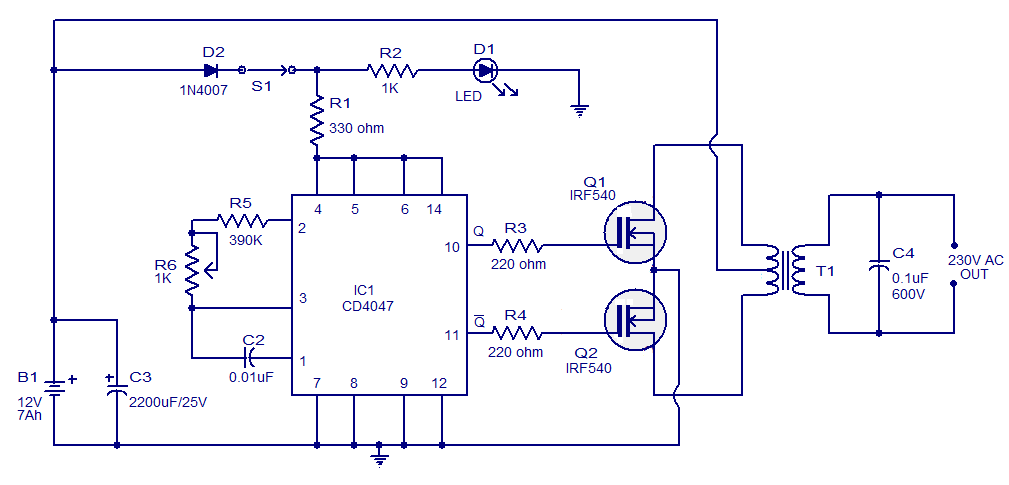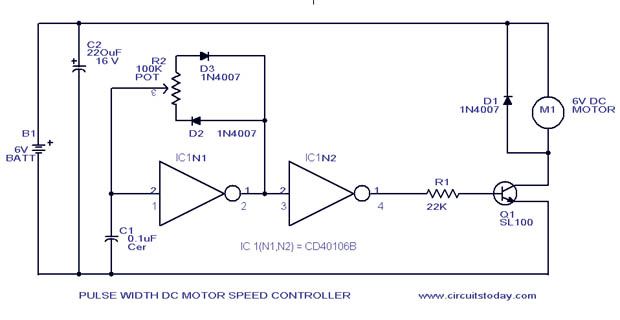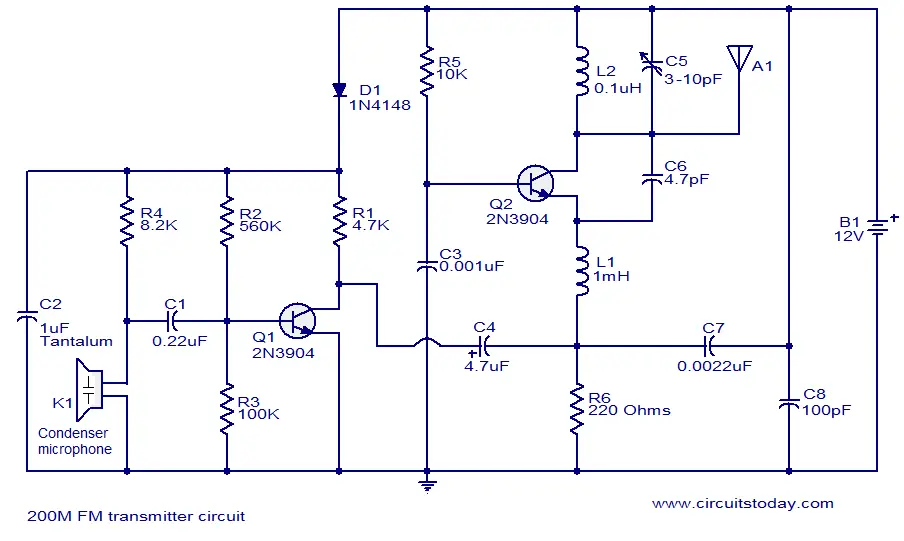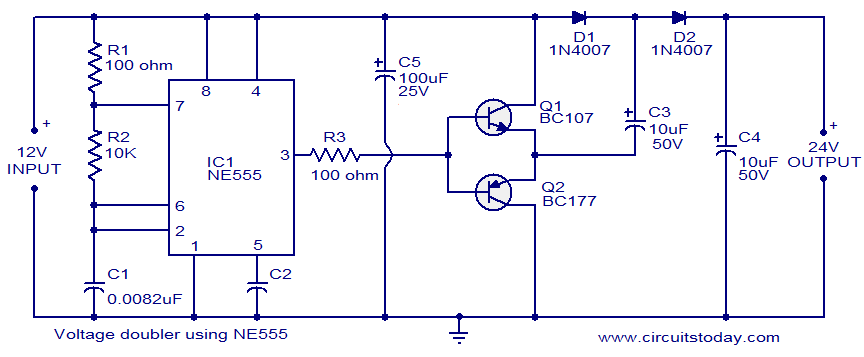
Custom Search
Sunday, September 26, 2010
How an Inverter works.
Inverter.
An inverter is used to produce an un-interrupted 220V AC or 110V AC (depending on the line voltage of the particular country) supply to the device connected as the load at the output socket.The inverter gives constant AC voltage at its output socket when the AC mains power supply is not available.
Lets look how the inverter makes this possible.To grasp the functioning of an inverter,we
should consider in the following situations.
* When the AC mains power supply is available.
* when the AC mains power supply is not available.
When the AC mains power supply is available.
When the AC mains supply is available,the AC mains sensor senses it and the supply goes to the Relay and battery charging section of the inverter.AC main sensor activates a relay and this relay will directly pass the AC mains supply to the output socket.The load will by driven by the line voltage in this situation.Also the line voltage is given to the battery charging section where the line voltage is converted to a DC voltage(12V DC or 24V DC usually),then regulated and battery is charged using it.There are special circuits for sensing the battery voltage and when the battery is fully charged the charging is stopped.In some inverters there will be a trickle charging circuit which keeps the battery constantly at full charge.
When the AC mains power supply is not available.
When the AC mains power supply is not available,an oscillator circuit inside the inverter produces a 50Hz MOS drive signal.This MOS drive signal will be amplified by the driver section and sent to the output section.MOSFETs or Transistors are used for the switching operation.These MOSFETs or Transistors are connected to the primary winding of the inverter transformer.When these switching devices receive the MOS drive signal from the driver circuit,they start switching between ON & OFF states at a rate of 50 Hz.This switching action of the MOSFETs or Transistors cause a 50Hz current to the primary of the inverter transformer.This results in a 220V AC or 110V AC (depending on the winding ratio of the inverter transformer) at the secondary or the inverter transformer.This secondary voltage is made available at the output socket of the inverter by a changeover relay.
Automation in an Inverter.
Inverter contains various circuits to automatically sense and tackle various situations that may occur when the inverter is running or in standby.This automaton section looks after conditions such as overload,over heat,low battery,over charge etc.Respective of the situation, the automation section may switch the battery to charging mode or switch OFF.The various conditions will be indicated to the operator by means of glowing LEDs or sounding alarms.In advanced inverters LCD screens are used to visually indicate the conditions.
Using inverters with AC generators.
Inverter systems can be in-corporated with generator systems to attain longer run-time when there is a cut in the mains power supply.The essential and critical loads require undisturbed power supply when the mains AC power supply falls for extended periods.The inverter can be used to power the critical and essential loads when the power supply fails.The generator can be started automatically or manually when the power cut extends for longer periods and the inverter battery becomes exhausted.In such a condition the inverter alone cannot provide necessary to the loads.
Instead of drawing power from the battery,the inverter draws power from the generator and continues to power the critical loads.In such a configuration the run time of the inverter will not be affected by the capacity of the battery.The extended run time can be also achieved by using extra batteries.But this method proves to be more costly and space consuming.Also unlimited run time cannot be attained by using extra batteries.
An inverter which is backed up by an AC generator is one of the most easy method to produce a power protection for prolonged time at minimum cost.Also the generator must be selected such that it can handle the effects of sudden changes in the load.The common habit is to use a generator with a rating of around 6 to 8 times that of the load.As an example a generator of 8KVA can be used for a house drawing 1KVA power.This could prevent a lot of problems associated with the generator as well as inverter.Also special care must bu taken to assure that the inverter will function properly with the AC generator.The common scheme for connecting an inverter with a generator is shown below.
100W inverter circuit
Pin 10 is connected to the gate of Q1 and pin 11 is connected to the gate of Q2. Resistors R3 and R4 prevents the loading of the IC by the respective MOSFETs. When pin 10 is high Q1 conducts and current flows through the upper half of the transformer primary which accounts for the positive half of the output AC voltage. When pin 11 is high Q2 conducts and current flows through the lower half of the transformer primary in opposite direction and it accounts for the negative half of the output AC voltage.
Notes.
Read more: http://www.circuitstoday.com/category/inverters-ups#ixzz10hrfoWk6
- B1 can be a 12V/ 6Ah lead acid battery.
- Q1 and Q2 must be fitted to a proper heat sink.
- T1 can be a 9-0-9 V primary, 230V secondary, 150VA transformer .
- Do not expect much from this circuit. The is very simple one suitable for low grade applications.
Read more: http://www.circuitstoday.com/category/inverters-ups#ixzz10hrfoWk6
Level Switch
Here is a simple level switch circuit that switches on one relay and switches off another relay when the fluid level exceeds the set limit.This circuit is a modification of the “Simple Water Level Indicator” previously posted.When the water level touches the probes positive supply is connected to the base of Q1 through fluid.This makes transistor Q1 ON.Base of Q2 is connected to collector of Q1 and base of Q3 is connected to collector of Q2.As a result Q1 will be on and Q2 will be OFF.So K2 will be OFF and K1 will be ON.Net result, we get two relays operating according to level ,one ON and Other OFF.The contacts of the relays OP1 and OP2 can be used according to your need to operate any device like motor,pumps,solenoid valves,light,alarm etc.When water level falls K2 will be ON and K1 will be OFF.
Notes
Read more: http://www.circuitstoday.com/level-switch#ixzz10hq9cnx3
Under Creative Commons License: Attribution
- Adjust R1 keeping probes touched in water to obtain the relay K1 ON.Then remove probes from water and see relay K1 goes OFF.During this time the opposite will be happening in K2.If you cannot attain the setting replace R1 with a 500K POT and repeat the procedure.That’s enough.
- For the probes cut 2 1 sqcm aluminum sheets and connect it to good quality insulated Aluminum wires. 2 cm spacing between probes is enough.Mount the two probes parallely at the desired level.Circuit is ready.
- One problem of this circuit is the corrosion of probes since DC is used.Any way this setup will run problem free for at least one year. We are developing a corrosion free version of the same circuit.That will be here soon.
Read more: http://www.circuitstoday.com/level-switch#ixzz10hq9cnx3
Under Creative Commons License: Attribution
Temperature controlled DC fan
PWM Motor Speed Control Circuit
Here is a simple PWM motor speed controller circuit that can be used for varying the speed of low power DC motors .The variation in speed is achieved by varying the duty cycle of the pulse supplied to drive the motor.Of the two gates of IC CD40106B ,N1 is wired as an inverting Schmitt Trigger astable multi vibrator for producing pulses and N2 as an inverting buffer to drive the transistor during positive cycles at base.The duty cycle is set from resistor R2. R1 limits the base current of transistor SL 100.The circuit is ideal for controlling toy motors,hand held mini fans , small blowers etc.
200M FM Transmitter
A very stable and simple FM transmitter circuit is given here. With a matching antenna, this transmitter can attain a range of around 200 meters. I assembled this transmitter few years and got very good results. Let us see how the circuit works.
A condenser microphone (K1) is used to pick the sound to be transmitted. Capacitor C1 is a DC decoupler and the sound signal is coupled to the base of Q1 which wired as a preamplifier.R2 and R3 are the biasing resistors of Q1. Amplified sound signal will be available at the collector of Q1 and it coupled to the emitter of transistor Q2 through the capacitor C4 and 1mH inductor L1. Capacitor C4 decouples the DC component from the preamplifier output. Q2 performs the job of oscillator and modulator. Inductor L2 and variable capacitor C5 forms the tank circuit necessary for creating oscillations. Capacitor C6 is the feedback capacitor. The modulated FM wave will be available at the collector of Q1 and it is transmitted using the antenna A1.
2 km FM transmitter
Notes.
- Assemble the circuit on a good quality PCB.
- The circuit can be powered from anything between 9 to 24V DC.
- Inductor L3 can be a VK220J type RFC.
- For L1 make 3 turns of 1mm enamelled copper wire on a 10mm diameter plastic former. On the same core make 2 turns of 1 mm enamelled copper wire close to L3 and that will be L2.
- Frequency can be adjusted by varying C9.
- R9 can be used to adjust the gain.
- For optimum performance, value of C8 must be also adjusted.
- Using a battery for powering the circuit will reduce noise.
http://www.circuitstoday.com/2-km-fm-transmitter#ixzz10eBAERgs
Voltage doubler circuit using NE555
The circuit diagram of a very simple voltage doubler using NE555 timer is shown here. Here IC NE555 The negative terminal of the capacitor C3 will be shorted to ground through T2 and it will be charged to the input supply voltage. When the output of the astable multi vibrator is high, transistor Q1 will be ON and transistor Q2 will be OFF. The capacitor C4 will be charged to the voltage across capacitor C3 plus the input supply voltage (that is double the input voltage). This is how the circuit works.
This voltage doubler circuit can deliver only up to 50mA output current and above that current limit the output voltage will be dramatically reduced. The actual output voltage will be around 19V for a 12V DC input and also the output voltage will be a bit unstable. Anyway, for low current applications this circuit is well enough.
Subscribe to:
Comments (Atom)




